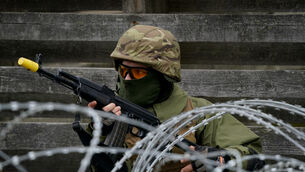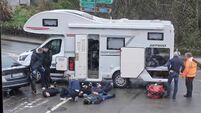Soham murders: Trial begins
The Old Bailey murder trial of Ian Huntley today heard details of the last movements of Soham schoolgirls Holly Wells and Jessica Chapman.
Richard Latham QC, prosecuting, began to set out the British Crown’s case against Huntley, 29, and his ex-girlfriend Maxine Carr, who is accused of conspiracy to pervert the course of justice and assisting an offender.
Both defendants deny the charges.
Mr Latham was opening the case against the former school caretaker and his ex-girlfriend.
Huntley denies the double child murder but has pleaded guilty to a single charge of conspiring to pervert the course of justice.
Carr, 26, a former classroom assistant at the girls’ primary school in Soham, Cambridgeshire, denies one charge of conspiracy to pervert the course of justice and two charges of assisting an offender.
The families of both girls were in court to hear the prosecution open its case and sat just a few feet from the dock.
Jessica’s parents Sharon Chapman, 44, a classroom assistant at the school the girls attended, and Leslie, 52, sat with her elder sisters Rebecca and Alison, now aged 18 and 15.
Holly’s older brother Oliver chose not to come to court but his parents Kevin Wells, 40, a contract cleaner, and his wife Nicola, 36, a legal secretary, sat near the Chapmans.
The disappearance of their daughters on August 4 last year triggered one of the biggest manhunts ever seen in Britain.
The girls’ remains were found 13 days later in an overgrown ditch in Lakenheath, Suffolk, on August 17.
Mr Latham told the jury of seven men and five women: "At 6.15 in the evening of Sunday August 4 of last year two girls, Holly Wells and Jessica Chapman, left Holly's home and walked out onto the streets of the small Cambridgeshire town of Soham.
“They were good friends, they went to the same school, they were in the same class.”
Earlier, the judge made a short statement before the jury came in which, unusually, he said could be published.
He warned the media against “highly coloured” and emotional coverage of the case.
He said: “It is the obligation to report accurately and without passion what happens in this court in the presence of the jury.
“It is an obligation not merely owed to the court but to the community and to those most acutely involved, the parents, friends and relatives of the deceased.”
Mr Justice Moses said the media should be responsible for the tone of their coverage and warned them to “temper emotion”.
Mr Latham said: "Within the first few minutes of leaving, they (the girls) were seen by a number of people.
“It was of course still daylight.
“They didn’t tell anyone they were going out.
“No doubt they felt secure and confident in an area where they felt familiar.
“They lived there, they went to school there, they would have thought they were surrounded by faces they knew.”
"The girls’ vanished shortly after 6.30pm," Mr Latham said.
There followed “one of the largest and most public missing persons inquiries that has ever taken place in this country”.
Mr Latham said: “Running in conjunction with the search was a police investigation designed to find whoever was responsible for their disappearance.
“Just under a fortnight later, in the early hours of Saturday August 17, Ian Huntley and Maxine Carr, who lived together at 5 College Close, were arrested on suspicion of the murder of the two girls.”
He said that hours before, just before midnight on the Friday, police had made a “very significant
find”.
He said: “The prosecution case is that these two girls fell into the hands of Huntley shortly after leaving home.
“For some reason known only to him he chose to murder them both.
“We allege that he went on to remove the bodies from Soham.
“We allege that he hid them in such a way that they would never be found.
“In this objective he was very nearly successful.”
Mr Latham said that Carr helped Huntley ``devise a dishonest account of events in order to distance himself from what he had done''.
The barrister said: “We do not suggest that Carr was in any way directly involved in the murders.
“Her part was to provide Huntley with support for a wholly dishonest account of his movements and actions during the critical period, the Sunday evening of August 4.”
Mr Latham said that Carr’s behaviour was not “an isolated judgment made on the spur of the moment”.
He said: “It was a calculated and cold blooded course… involving repeated lies throughout the period of the disappearance of the girls and her arrest.”
The court heard the pair were arrested in the early hours of Saturday morning and that by chance the same day three members of the public found the remains of Holly and Jessica.
Mr Latham explained to the jury that this case was not like many trials which involve a smaller number of witnesses and evidence and that they would be hearing from a large number.
He stressed that although the case was complicated in that sense, it was not difficult to understand.
He reminded the jury again that the case involving the alleged murder of two 10-year-olds was “by definition distressing”.
But he urged them to remain objective and to maintain that “objectivity, concentration and careful analysis” of the facts.
He also reminded the jury that it was very important for them to put out of their minds any recollection they may have from previous reports of the case.
Mr Latham explained that his opening should not be treated as evidence but simply as his allegations about what had happened.
“If the evidence does not accord with what I am telling you, please rely on the evidence and not what I have said,” he said.
“It will be safer if you treat anything I say as an allegation until it is either admitted as a fact or proved so that you are sure about it.”
He said the jury would see documentary and physical exhibits from the case and would hear evidence from witnesses called to court and from statements which would be read out.
And he said that maps and plans of Soham would be an important part of the case, adding that the geography of the market town was very important.
The jury would also be visiting Soham on Monday next week, he said, and would be taken on Tuesday to the spot near Lakenheath where the bodies were found.














